How to Stretch Middle Back
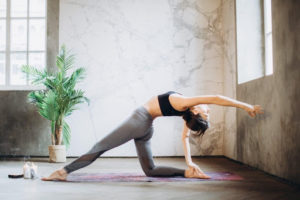
We often come across people complaining about lower back pain. Middle back pain is just as common as lower back pain. It’s a pain you feel after sitting at a desk for long hours.
Middle back pain can affect your everyday life significantly. But the good news is, you can help relieve the pain with just a few stretches.
Before we talk about some of our favorite stretches to get rid of mid back stiffness, let’s take a look at some of its symptoms:
- Muscle stiffness or tightness
- A short, sharp pain
- A pinched nerve
- A constant, dull ache
- A reduced range of movement
Many factors contribute to mid-back pain, including injuries, medical conditions like arthritis or fractured vertebrae, age, and lifestyle factors. So, if you’re facing any of these symptoms, it’s time to incorporate stretching into your daily routine. Remember, sparing 10 to 15 minutes daily to stretch can make a huge difference in how your back feels.
Below-mentioned are some great stretches specifically to help relieve your mid back pain, loosen the tight muscles, and improve mobility.
6 Best Stretches to Relieve Your Middle Back Pain
Seated Twist
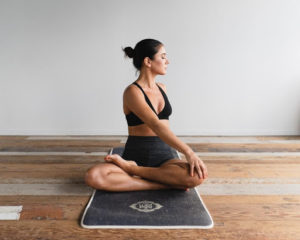
Does your work demand that you sit for long hours every day? If you sit with hunched shoulders, you’re likely to have stiff middle back muscles, which will limit your spine’s ability to twist.
First and foremost, you should put more emphasis on sitting straight. Be conscious about your posture, and keep your back upright whenever you sit to work.
In addition to taking care of your posture, consider doing a stretch called seated twist. This stretch will help you determine your back muscles’ stiffness and will eventually provide you with the enhanced flexibility of moving in both directions.
Steps for the Seated Twist:
- Sit sideways on a chair. If not on a chair, you can also consider sitting on the floor with your legs crossed. Be sure to sit straight as you need to keep the spine long
- Now, inhale and twist to the left side slowly. Next, as shown in the image, place your right hand on the outside of the left knee and the left hand behind the back
- Stay in this position for around 20 to 30 seconds
- Exhale and return to the original position
- Repeat the same on the other side
Do the seated twist stretch three to four times per side. Performing it when working at a desk throughout the day will provide you relief from middle back pain.
Cat-Cow Pose
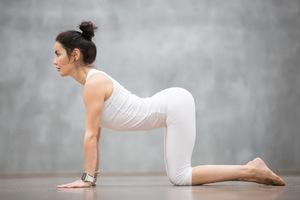
The cat-cow pose is a simple and gentle stretch done to loosen the shoulders and muscles across the spine. This stretch will not only help in releasing stiffness in the mid back but will also increase your overall flexibility.
Steps for the Cat-Cow Pose:
- Start with placing your hands and knees so that the wrists should be below the shoulders and knees below the hips. Balance your body properly by spreading your fingers wide. Press your palms and fingertips down, as this will help distribute your weight evenly. Keep your spine in a neutral position
- Now, inhale and allow the stomach to drop towards the ground and pelvis in an upward direction. This should bring your chest forward. Lift your head and keep your neck relaxed. This is your cow stretch
- Hold this stretch for a breath or two
- Exhale and arch your back, the way a cat does. Tuck in your pelvis by tilting it toward the ribs, round your spine, and let your head drop toward the floor. This position should form a C with your spine. Move your shoulder blade away from your spine. This is a cat stretch
- Again, hold for one or two breaths before going back to the cow position
- Repeat the same thing at least 5 to 7 times
Doing this stretching pose will warm up your body and loosen your muscles, which will help alleviate your middle back pain.
Passive Backbend

Had a long day at work? Try this passive backbend stretch to bring relief as it stretches the chest, the scalene neck muscles, and the serratus muscles.
You can use any props you can find at home – a foam roller, a yoga mat, or even a rolled-up towel.
Steps for the Passive Backbend Stretch:
- Roll up the yoga mat or towel and place it on the floor
- Lie down and place the roll beneath your shoulder blades. It should be close to your middle back. If your head needs elevation, consider placing something under it in a way that your neck feels supported
- Spread your arms wide in a way that they are away from your body and relax while breathing deep and long
- Stay in this position for a couple of minutes
Incorporating the passive backbend stretch will help reduce tension, increase back flexibility and also improve your posture.
Cobra Pose
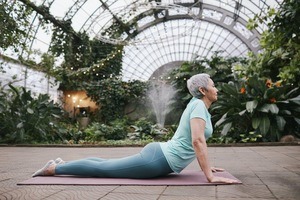
Stretch and strengthen your back as this cobra pose focuses on active back bending. While people having mid back pain may find it a bit difficult at first, it is recommended to try. However, do not push your boundaries or go beyond your comfort level.
Steps for the Cobra Pose:
- Lie on your stomach while face down on the floor. Extend your legs in a way that the toes and fingers of your feet are resting on the ground
- Now, place your hands under your shoulders, bend the elbows and bring the arms towards your body
- Lift your chest from the ground by using your back muscles. At this point, it’s recommended to test your back engagement by lifting your hands off the ground for a moment
- Deepen this stretch by pressing your hands down lightly. The major bend should come from the back; give a little extra push with your hands
- Stay in this position for the next 20-30 seconds. Then, return to the original position gently and repeat the same process around two to four times
The cobra pose helps stretch your chest while strengthening your back, including the muscles along the spine. It is considered one of the most effective ways of releasing back tension and improving your posture.
Bridge Pose
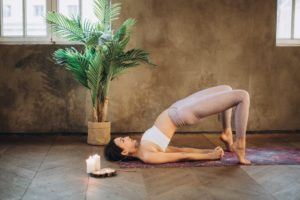
This bridge pose is a stretch that strengthens the muscles that run along the spine and the ones in the abdomen and buttocks. This is a gentle stretch that places slight pressure on the neck. It’s recommended to refrain from turning your head and simply gaze up to a single point on the ceiling or sky to avoid any neck issues.
Steps for the Bridge Pose:
- Lie down on your back. While keeping your feet flat on the ground, bend your knees in a way that your hands can touch your heels
- Squeeze your buttocks, press your shoulder towards the floor, and gently stretch them to your back. This posture should puff out your chest slightly
- Put some pressure on your feet and lift your hips. Clasp your hands underneath you. At this point, your shoulders are supporting your body weight
- Stay in this position for around 5 seconds. Do not stop squeezing your buttocks
- Now, gently lower your body down to its original position while unclasping your hands
- Repeat the same thing three more times. Be conscious while you enter and exit the posture
Performing the bridge pose will help you with your mid back pain and help you maintain an upright posture while standing or sitting.
Child’s Pose
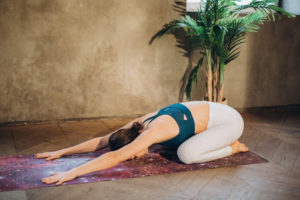
This is a quite simple and relaxing pose that allows the spine to stretch passively. It specifically stretches the core abdominal muscles by keeping the knees apart. Additionally, as you place your arms over the head, a large flat muscle called latissimus dorsi that connects the long arm bone and spine also gets stretched gently.
Steps for the Child’s Pose:
- Kneel in a way that your hips and buttocks rest on your lower legs and feet
- Now, spread the knees apart to the extent that is comfortable for you
- Begin folding your body in the forward direction. This should bring your chest down, near to your knees
- Stretch your arms out in the front and keep them straight. Rest your hands gently on the floor, and if possible, rest your forehead too
- Hold this position for around 20 to 30 seconds
- Return to the original upright position by using your hands
Your entire back will feel better with this stretch. However, be sure to keep your neck and shoulders relaxed while carrying out the child’s pose.
Final Thoughts
Apart from the stretches mentioned above, considering certain simple steps like staying mobile, practicing good posture, opting for complementary therapies including massage and acupuncture may help reduce pain and prevent its recurrence.
Never ignore back pain, or else it can affect your general health and wellbeing. Instead, incorporate regular stretching into your day to loosen and strengthen the muscles. This will eventually help to reduce your middle back pain and also improve your posture.
For more advice see our article “How Can Stiff and Tight Muscles Result in Back Pain“.
So, are you ready to dedicate 10-15 minutes every day from your busy schedule for stretching? Have you been doing any of these stretches? If yes, what was the outcome? Do share your results with us in the comments.